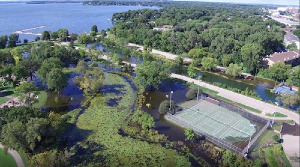
Four years. Five phases. Six sites. That’s the scope of the $10-15 million Yahara River Sediment Removal Project, part of Dane County’s ongoing flood mitigation effort. It is an ambitious project that aims to cut in half the amount of time it takes for water to travel through the Yahara watershed.
Inefficient movement of water through the Yahara River and its watershed heightened the flooding in 2018— resulting in one casualty and approximately $209 million in damages.
One major reason for the slow flow of water was, and is, sediment buildup. Large sediment deposits hinder the movement of water by creating friction between the water and sediment, and can also raise riverbeds, decreasing flood water storage capacity. Though sediment accumulation is a natural consequence of erosion, this natural process has been exacerbated by urbanization in Madison and Dane County.
Population and development in the Dane County area has increased the amount of impervious surfaces such a pavement. This leads to an increase in surface water runoff. Runoff in greater Dane County brings 8.5 million pounds of sediment to the Yahara Watershed each year as the rivulets of water travel to local rivers. A flooding task force formed by the County Board advised extensive dredging along the Yahara River to alleviate flow restrictions.
The Yahara River Sediment Removal Project is one realization of the task force recommendations. The plan is to dredge 11 miles of the Yahara River, potentially lowering the riverbed by a foot. This would decrease flooding risk by increasing the flow of water through the Yahara watershed and expanding its water storage capacity. In addition to flood mitigation, the initiative will help restore fish and wildlife habitats and improve water quality.
While the Yahara River Sediment Removal Project is comparable to Dane County’s $12 million “Suck the Muck” initiative, the latter is aimed at controlling toxic algae blooms, rather than mitigating flooding risks. “Suck the Muck” removes phosphorus-rich legacy sediment from streambeds, which has been fueling toxic algae blooms in the lakes.
The first phase of the Yahara Sediment Removal Project began earlier this summer and targets a stretch of the Yahara River between Lake Monona and Lake Waubesa. The goal is to remove over 3,000 dump truck loads of sediment from an area 50 feet wide and one and one-half miles long. Phase one of the project is expected to conclude this year. Dane County awarded the $3.25 million contract to Dredgit Corporation, a construction company based in Houston, Texas.
Future phases, however, may be undertaken by the county. County Executive Joe Parisi included $5 million in the 2020 budget to hire staff and purchase equipment for sediment removal. Engineering plans are currently in development for the second phase, which will remove sediment from the Yahara River between Lake Waubesa and Lower Mud Lake, as an area between Lake Kegonsa and Highway B.
The Yahara Sediment Removal Project is a promising effort that many believe will reduce the risks associated with flooding.
“With this initiative, Dane County will work to increase the flow of water through the Yahara Chain of Lakes and mitigate future flooding risk,” said County Executive Joe Parisi.
[Sources:
Madison.com
;
NBC 15 News; Janesville Gazette; Dane County Land and Water Resources Department
]

